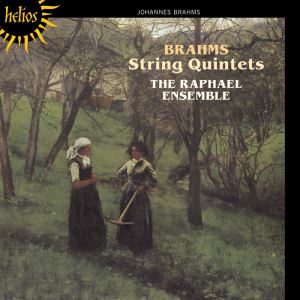 |
 |
|


alternatively
CD: MDT
AmazonUK
AmazonUS |
Johannes BRAHMS
(1833-1897)
String Quintet No. 1 in F major, Op. 88 (1882) [28:22]
String Quintet No. 2 in G major, Op. 111 (1890) [29:37]
 The Raphael Ensemble (Anthony Marwood, Elizabeth Wexler (violins);
Timothy Boulton, James Boyd (violas); Andrea Hess (cello))
The Raphael Ensemble (Anthony Marwood, Elizabeth Wexler (violins);
Timothy Boulton, James Boyd (violas); Andrea Hess (cello))
rec. St. George’s, Brandon Hill, Bristol, UK, 18-20 April
1995. DDD
 HYPERION HELIOS CDH55369 [58:07]
HYPERION HELIOS CDH55369 [58:07] 
Sound
Samples
|
|
|
Brahms’ two string quintets, which he composed later in
life, are arguably his greatest achievements for strings alone.
They are very rich in themes and are masterfully constructed;
neither contains a dull moment. His famous Piano Quintet, Op.
34, composed much earlier, also began life as a string quintet
- though with an extra cello rather than viola - before becoming
a work for two pianos and finally in the form it is most often
performed today. The later string quintets are modelled on those
by Mozart with the extra viola rather than Schubert’s
C major with its added cello. It’s strange that such glorious
works as these by Brahms are not recorded more often. Part of
the reason may be that tuning can be a problem with these quintets.
My introduction to them was with the recording made by the Budapest
String Quartet and Walter Trampler, viola, back in the 1950s
or early 1960s. I have that one on LP. Since then I purchased
the Sony CD of the Juilliard Quartet also with Trampler that
was recorded in the same year as the one I am reviewing here.
I always loved the Budapest account, but could never warm to
the Juilliard’s largely because of the suspect tuning.
The culprit here, it seems to me, was the violist. He was famous
as a chamber musician, but by 1995 I fear he had lost his ability
to play in tune, or his vibrato had grown to the degree that
he sounds out of tune a fair amount of the time. He did not
seem nearly as well matched as he had earlier with the Budapest.
At any rate, I could never stand to listen to that recording
for very long. It just didn’t measure up to my expectations
based on my fondness for the Budapest record. With the Raphael
Ensemble I can now enjoy these great works as I used to and
their tuning seems fine to me.
Originally issued on a full-price Hyperion CD, this Helios reissue
is welcome indeed. From the joyful first movement, through the
slow movement with its two lighter interludes and the high-spirited
finale, the Op. 88 receives a beautifully heartfelt performance
that is as well played as I have heard it. For example, listen
to the passage near the end of the slow movement, beginning
at around 9:08 for aching lyricism that is so typically Brahmsian
and so poignantly projected here. Then contrast this with the
fugal finale that really dances and sings. The Op. 111 work
is no less remarkable in its more traditional four movements.
Special mention should be made of the first movement’s
second subject with its paired violas from 1:15-1:50 and repeated
later in the exposition and then again in the recapitulation,
one of those ineffable themes that melts the heart and is so
typical of Brahms especially in his late works. Likewise, the
third movement Un poco allegretto, which is reminiscent
of its equivalent in the Symphony No. 3, receives sensitive
treatment here that perfectly captures its wistful spirit. The
finale, like that of the earlier quintet, contains the dance
element, even if it is more subdued than that of Op. 88. All
of the various moods of both quintets are as well captured here
as one could hope for.
Even though the disc is budget priced, there is nothing whatsoever
parsimonious about its presentation from the cover art to the
very thorough and insightful notes that describe both quintets
in considerable detail. If you do not know these wonderful works
or in the market for a recording of them, I can think of no
better option than this brilliantly performed and recorded one
by the Raphael.
Leslie Wright
|
|

